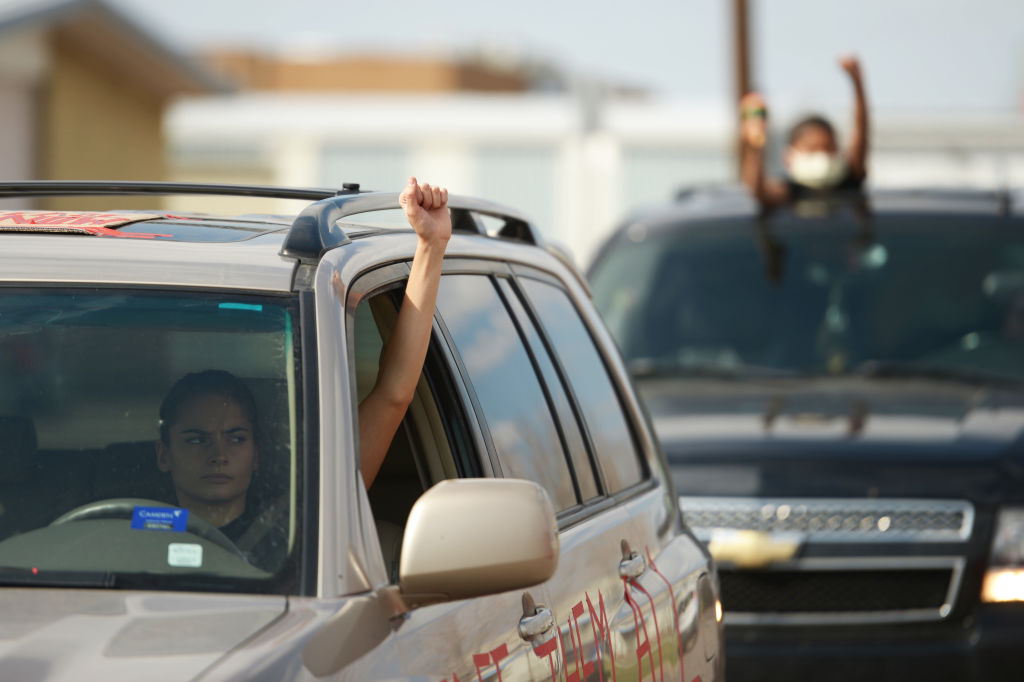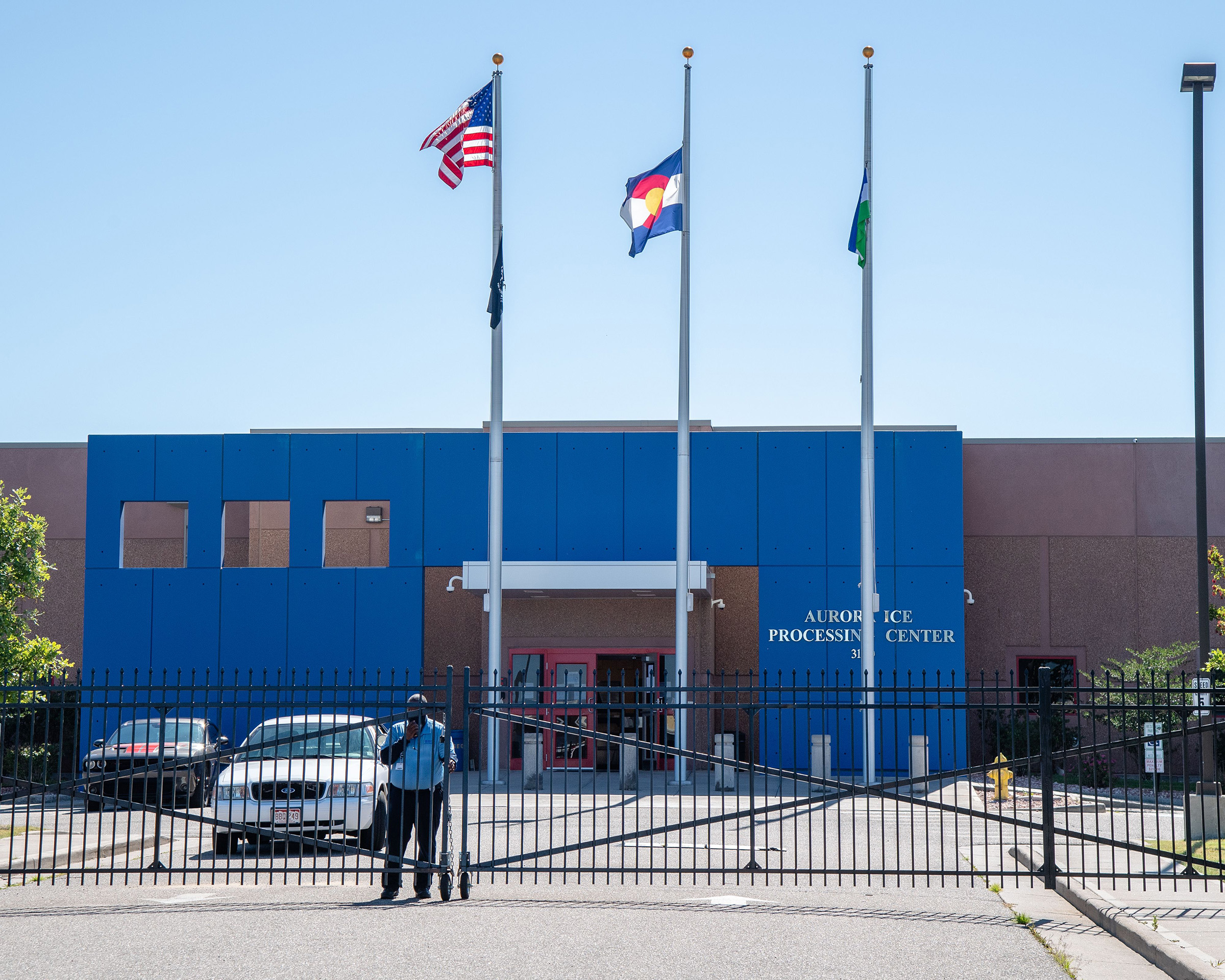When 29-year-old Raul Medina Perez stepped outside of the Aurora Contract Detention Facility on July 7, after nearly 11 months in immigration detention, he was greeted by a crowd of activists in the Colorado city who raised $8,000 to pay for his bail. In a state of disbelief, he held his fist in the air and his mother, Rosa Perez, cried on his shoulder.
Rosa, a housekeeper who participated in protests every day for her son’s release, says she would not have been able to pay Raul’s bail on her own. “When the pandemic started, when coronavirus started, it was a moment of anguish, anguish and a lot of pain because I was worried my son would get infected and I wouldn’t be able to do anything about it,” Rosa tells TIME in Spanish.
Some of the Aurora activists who raised money for Raul’s bail tell TIME that Raul’s release from detention is an example of the success of their evolving strategy, which has escalated in recent months amid the coronavirus pandemic. The national movement to end Immigration and Customs Enforcement (ICE) detention and to “abolish ICE” has existed since at least 2018, and was helped along into the mainstream by high profile progressives like Sen. Bernie Sanders and Rep. Alexandria Ocasio-Cortez. However, as the coronavirus spread across the U.S., killing more than 140,000 people and infecting more than 3.7 million, fears mounted for those being held in ICE detention, and calls for abolition and the release of detainees have become louder.
These activists for example, have camped outside of the Aurora facility, where roughly 400 people are still detained, for more than 50 days, protested in caravans of vehicles that drive around the facility, and have held vigils every night. But, they say, their successes happen far too infrequently.

“We believe that immigrants aren’t criminals and should never be criminalized, so facilities like [Aurora] shouldn’t exist, period,” Isabel Villalon, one of the camp protesters and a member of the organization Abolish ICE Denver, tells TIME. “That’s something Abolish ICE has been fighting for for years, not only in Denver, but nationwide. Once COVID hit, that call to action became more urgent because now lives were at stake and there was an immediate need to do what we could to save lives.”
Lawyers, advocates, researchers, politicians, medical professionals and the detainees themselves have criticized how ICE has responded to the pandemic. They worry that continued ICE deportations and transfers of detainees to and from facilities exposes people to the virus. They also worry about detainees being exposed to guards who come in and out of the facilities daily. Some detainees at three detention facilities, including Aurora and facilities in Texas and California, tell TIME it is difficult to regularly receive personal protective equipment (PPE). They say it is impossible to properly social distance in a detained setting with shared communal spaces. Cases of COVID-19 have also been confirmed by foreign countries receiving people who have been deported by ICE.
Several lawsuits against the Trump Administration also make these allegations. GEO Group—the private company contracted by ICE to run the Aurora facility—vehemently denies any allegations that it has improperly responded to the pandemic.
More than 22,000 people are currently in ICE custody, according to ICE data, including children, people seeking asylum and, in some instances, violent criminal offenders (according to data by the Transactional Records Access Clearinghouse, 64% of ICE detainees as of April 2019 had no criminal convictions). As of Monday July 20, ICE reports 3,657 people who have been in ICE custody have tested positive for the virus. An additional 45 ICE employees at detention centers have also tested positive. ICE does not report the number of contracted employees who test positive, such as those who work for GEO. At the Aurora facility, for example, 12 GEO employees have contracted the virus as of July 8, according to a report by Congressman Jason Crow.
Nationally, two ICE detainees have died of COVID-19 while in custody at facilities in San Diego and Atlanta, and a third man died from the virus shortly after he was released from custody in Ohio. On July 13, ICE announced a third man died while in custody in Miami. Though his exact cause of death has not been determined, the man did test positive for COVID-19 and was hospitalized on July 1 after reporting shortness of breath.
The Aurora facility confirmed its first detainee case of COVID-19 on May 21. By May 23, Abolish ICE Denver had set up a tent encampment on a grassy patch of land outside of the facility in protest. Among the roughly 50-tent set up are Kesha Davalos, her 7-year-old daughter and her mother, who have all camped out in front of the facility for weeks. Davalos’s husband was detained inside the facility for about six months. On Saturday July 11, Davalos learned her husband was transferred to another facility in Colorado without notice.
“This is just another reason why I should continue fighting at this encampment,” she tells TIME. “What [ICE is] doing is wrong. I will keep fighting for this system to go down.”
While protesters remain camped outside of the Aurora facility, other detention centers and the federal government are facing lawsuits, petitions and other protest actions in an attempt to release people from ICE detention. On June 26 a judge ordered ICE to release all children in its custody by July 17—though that deadline was later extended to July 27—and an additional lawsuit brought against the Trump Administration by 37 families detained at ICE family residential centers calls for all parents to be released along with their children because of the risks posed by COVID-19.
On Thursday, the American Federation of Government Employees, a federal employee union, announced that some employees of ICE and Customs and Border Protection joined a lawsuit against the federal government claiming they are entitled to hazard pay for “hazardous working conditions through the performance of their assigned duties” brought on by COVID-19.
“[ICE gets] away with things that are just beyond me,” Raul tells TIME in an interview shortly after his release. “They don’t treat us like humans, they don’t even treat us like animals. They treat us like a number, they treat us like a number or a dollar sign, and that’s not okay.”
Raul says that GEO is not keeping detainees safe from the virus; often, he says, up to four people live in small cells together in bunk beds only 3-feet apart. He says detainees only learned of the virus through news on televisions at the facility, and that when they did, they asked to be tested and to receive PPE, which GEO employees denied them of at first, citing Centers for Disease Control and Prevention (CDC) guidance at the time that masks weren’t necessary. He says that as the pandemic has continued in the U.S. for several months, guards have become more and more lax on wearing masks.
Davalos, and two other women who have husbands detained in the Aurora facility, made similar allegations to TIME. Claudia Robles, who’s husband has asthma and has been detained since November, for example, tells TIME that her husband has struggled to acquire soap and water and said it is impossible to social distance.
“We strongly reject these baseless allegations,” GEO spokesperson Christopher Ferreira said in a statement to TIME. “We take our responsibility to ensure the health and safety of all those in our care and our employees with the utmost seriousness.”
Additionally, ICE says it has followed guidelines from the CDC. “ICE continues to incorporate CDC’s COVID-19 guidance, which is built upon the already established infectious disease monitoring and management protocols currently in use by the agency,” Mary Houtmann, a spokesperson for ICE, said in a statement to TIME.
On March 24, ICE confirmed its first diagnosed case of COVID-19 at one of its facilities, but it wasn’t until June 9 that ICE announced it had begun mass voluntary testing beginning with two of its facilities, one in Tacoma, Wash., and the Aurora facility. ICE has since conducted similar mass testing at several other facilities. Prior, testing was conducted on a case-by-case basis when a person exhibited signs of illness.
Research by a nonprofit organization estimates that the number of COVID-19 cases in ICE detention centers could be a lot higher than reported. By building an epidemiological model, researchers at the Vera Institute of Justice, which aims to decrease incarceration in the U.S., predict that cases of the virus in people detained by ICE between March 17 up to May 15 could be more than 10 times higher than what ICE has reported.
“The model suggests there’s no scenario in which the numbers that have been reported to the public reflect the true scope of COVID in detention,” says Nina Siulc, director of research at the Vera Institute. “It’s too late to know for the 66,000 people who have passed through custody, how many of them may have been exposed to or [became] positive for COVID.”

“Since the beginning of this issue, ICE has made great efforts to be transparent, providing detailed, continues [sic] information related to COVID-19 on our public facing website,” Houtmann said in an emailed statement. “Any allegation to the contrary is simply not true.”
Since the start of the camp protest, the Aurora Police Department has responded to at least 26 different incidents at the facility as of July 15, according to police spokesperson Matthew Longshore. “These incidents range from trespassing on their private property to employees being harassed as they enter/exit the facility. One of the most recent incidents involved the protesters kicking the fence and shooting off fireworks,” Longshore said in a statement to TIME. No arrests have been made.
But the protesters say that they are within their legal rights to protest what is happening inside of the facility and deny they are trespassing or harassing anyone.
“The objective is to save lives,” Jeanette Vizguerra, founder of Abolish ICE Denver, tells TIME in Spanish. “[ICE is] risking people’s lives right now…COVID-19 isn’t going away today, it’s not going away tomorrow, or in weeks, but Homeland Security is still working, Homeland Security is still detaining people, still deporting people.”
The protest outside the center at Aurora continues and Raul said it was comforting while he was in ICE detention to see footage of the protesters gathered outside the facility through news stories about their camp protest and vigils. His mother, he knew, was among them, and he too now plans to become a regular part of the movement.
“I came out here and I felt like I was a part of this,” he says. “I felt like everybody was here for me and believed in me, and it’s such a comforting feeling and I want to be able to give that to the next person that walks out that door.”
More Must-Reads from TIME
- Donald Trump Is TIME's 2024 Person of the Year
- Why We Chose Trump as Person of the Year
- Is Intermittent Fasting Good or Bad for You?
- The 100 Must-Read Books of 2024
- The 20 Best Christmas TV Episodes
- Column: If Optimism Feels Ridiculous Now, Try Hope
- The Future of Climate Action Is Trade Policy
- Merle Bombardieri Is Helping People Make the Baby Decision
Write to Jasmine Aguilera at jasmine.aguilera@time.com